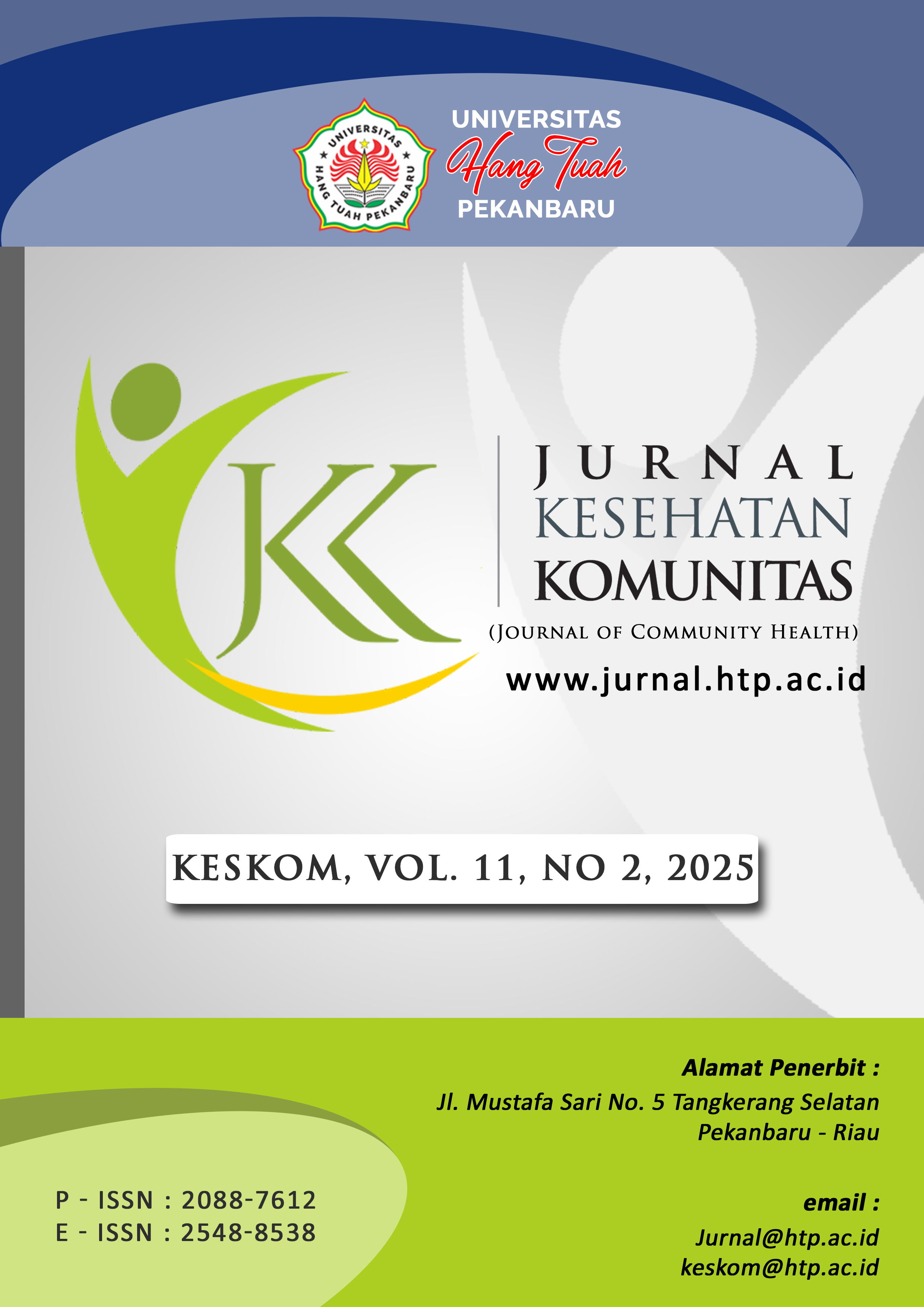The Influence of Family Emotional Support on the Incidence of Depression in Adolescents
Nursing Family, Depretion, Adolelecent
DOI:
https://doi.org/10.25311/keskom.Vol11.Iss2.2220Keywords:
emotional support system, familly, depresion, AdolescentAbstract
Depression in adolescents is a significant mental health problem. One factor that can influence the incidence of depression in adolescents is family emotional support. This study aims to examine the effect of family emotional support on depression in adolescents. The purpose of this study was to analyze the effect of family emotional support on the incidence of depression in adolescents and to evaluate the level of emotional support provided by families to adolescents. This study used a cross-sectional design with questionnaires distributed to 202 adolescents aged 15-21 years. Data were analyzed descriptively and with statistical regression tests to assess the relationship between family emotional support and the incidence of depression. As many as 78.7% of adolescents felt comfortable with family emotional support, but 32.18% reported that their families often did not ask about their condition. Overall emotional support reached 67.3%. The study also found that female adolescents were more susceptible to depression although age, gender, and education factors did not show a significant relationship. Family emotional support plays an important role in reducing the impact of depression in adolescents. Although overall emotional support is good, many adolescents feel they are not getting enough attention from their families. Family emotional support has an effect on preventing depression in adolescents. Families need to pay more attention to the emotional needs of adolescents and improve counseling services to help parents understand their children's emotional conditions.
Downloads
References
[1] Riskesdas. (2018). Laporan Nasional Riset Kesehatan Dasar 2018. Jakarta: Badan Penelitian dan Pengembangan Kesehatan, Kementerian Kesehatan RI.
[2] World Health Organization. (2018). Adolescent mental health. Geneva: WHO. Tersedia dari: https://www.who.int/news-room/fact-sheets/detail/adolescent-mental-health
[3] Kementerian Kesehatan Republik Indonesia. (2019). Profil Kesehatan Indonesia 2019. Jakarta: Kemenkes RI.
[4] Kusumawardani, N., Tarigan, I., & Wiryawan, Y. (2016). Kesehatan mental remaja: Tantangan dan strategi penanganannya di Indonesia. Jakarta: Pusat Kajian Kesehatan Masyarakat.
[5] Stuart, G.W. (2016). Principles and practice of psychiatric nursing (10th ed.). St. Louis: Elsevier Health Sciences.
[6] Fitria, Y., & Maulidia, F. (2018). Dukungan keluarga terhadap remaja yang mengalami depresi. Jurnal Ilmu Keperawatan, 6(1), 45–51.
[7] Dworkin, J., & Serido, J. (2017). Parental support and adolescent well-being. Youth & Society, 49(4), 563–585.
[8] Fakhrou, R. A., et al. (2023). Family communication and youth mental health outcomes. Child Psychiatry & Human Development, 54(2), 311–325.
[9] Izzo, C., et al. (2022). The role of emotional support in adolescent depression. Journal of Adolescent Health, 70(6), 894–901.
[10] Simanjuntak, R. A., et al. (2022). Tanda-tanda depresi pada remaja berdasarkan studi epidemiologis. Jurnal Psikiatri Nusantara, 4(2), 150–158.
[11] Huang, Y., et al. (2023). Progression of depression from mild to severe: A systematic review. The Lancet Psychiatry, 10(3), 240–253.
[12] Mehulić, I., & Kamenov, Z. (2021). Severe depression: Symptoms and societal burden. Current Psychiatry Reports, 23(11), 68–77.
[13] Soumokil-Mailoa, A. M., et al. (2022). Perubahan perilaku remaja sebagai indikator depresi. Jurnal Psikologi Indonesia, 39(1), 70–78.
[14] National Institute of Mental Health. (2023). Major Depression. https://www.nimh.nih.gov/health/statistics/major-depression.shtml
[15] Beutel, M. E., et al. (2019). Gender differences in depression and quality of life in Germany. Journal of Affective Disorders, 253, 342–349.
[16] Schlax, J., et al. (2019). Symptoms and risk factors of depression among adults. Psychosocial Medicine, 16, Doc03.
[17] Streit, F., et al. (2022). Gender differences in emotional disorders and comorbidities. Journal of Affective Disorders, 301, 140–148.
[18] Cao, L., & Rammohan, A. (2016). Urban-rural disparities in mental health in China. Health & Place, 42, 118–127.
[19] Damodaran, D., & Paul, S. (2016). Mental health in Indian adolescents: A gender perspective. Indian Journal of Psychiatry, 58(3), 315–319.
[20] Busfield, J. (2012). Gender and mental health: An overview. Sociology Compass, 6(11), 850–861.
[21] Rosenfield, S., & Smith, D. (2012). Gender and mental health. Handbook of the Sociology of Mental Health, 277–296. DOI: https://doi.org/10.1007/978-94-007-4276-5_14
[22] Chew, B. H., et al. (2016). Emotional disorders among Malaysian adolescents: A gender comparison. BMC Public Health, 16, 1001.
[23] Chew, B. H., et al. (2017). Mental health issues in adolescents: A Malaysian overview. Journal of Adolescent Health, 61(2), 240–245.
[24] Chong, S. A., et al. (2012). Prevalence of mental disorders in Singapore: A gender-based analysis. Psychiatry Research, 198(2), 153–159.
[25] Arfianto, D., et al. (2023). Gender gap in adolescent mental health. Indonesian Journal of Psychiatry, 10(1), 45–53.
[26] Samraj, R., et al. (2023). Psychosocial stress and adolescent girls in Southeast Asia. Asian Journal of Psychiatry, 80, 103331. DOI: https://doi.org/10.1016/j.ajp.2022.103331
[27] Tina, H. (2019). Dampak gangguan emosional pada remaja perempuan. Jurnal Keperawatan Remaja, 5(2), 101–108.
[28] Kondirolli, L., & Sunder, S. (2022). Education and emotional health outcomes. Social Psychiatry and Psychiatric Epidemiology, 57(5), 923–932.
[29] Niemeyer, H., et al. (2019). Socioeconomic status and mental health: A meta-analysis. Psychological Bulletin, 145(5), 512–545.
[30] Wan, M. J., et al. (2015). Education and adolescent mental health in Asia. Asian Journal of Psychiatry, 17, 52–58.
[31] Chairurrijal, M., et al. (2019). Pendidikan dan risiko gangguan emosional pada remaja. Jurnal Psikologi Indonesia, 38(2), 112–120.
[32] Khatimah, H., et al. (2022). Tingkat pendidikan dan gangguan kesehatan mental remaja. Jurnal Penelitian Kesehatan, 20(3), 189–196.
[33] Nasriati, R. (2017). Stigma and Family Support in Caring for People With Mental Disorders (ODGJ). Jurnal Ilmiah Ilmu - Ilmu Kesehatan, XV(1), 56–65.
[34] Fakhrou, A. A., Adawi, T. R., Ghareeb, S. A., Elsherbiny, A. M., & AlFalasi, M. M. (2023). Role of family in supporting children with mental disorders in Qatar. Heliyon, 9(8), e18914. https://doi.org/https://doi.org/10.1016/j.heliyon.2023.e18914 DOI: https://doi.org/10.1016/j.heliyon.2023.e18914
Downloads
Submitted
Accepted
Published
How to Cite
Issue
Section
License
Copyright (c) 2025 Jurnal kesehatan komunitas (Journal of community health)

This work is licensed under a Creative Commons Attribution-NonCommercial-ShareAlike 4.0 International License.
Copyright @2017. This is an open-access article distributed under the terms of the Creative Commons Attribution-NonCommercial-ShareAlike 4.0 International License (http://creativecommons.org/licenses/by-nc-sa/4.0/) which permits unrestricted non-commercial used, distribution and reproduction in any medium












































